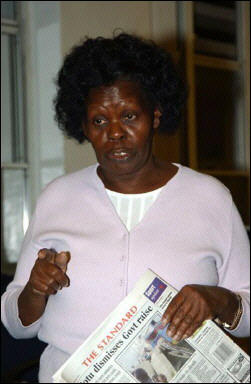There's a Deeper Level to this Conversation: As You Tear At Each Other About Who's Sponsoring the Gen Z Protests, or Even if They're Sponsored at All, Watch These Three Videos and Let Me Know What You Think...
%20(15).jpeg)
The Legacy of Fear: How the Shadow of Jaramogi Oginga Odinga Shaped Kenya's Political Landscape
In the annals of Kenya's political history, the events of 1969 stand out as a defining moment marked by fear, coercion, and manipulation.
The political tension surrounding Jaramogi Oginga Odinga's candidature led to a series of oath-taking ceremonies in Gatundu that forever altered the fabric of Kenyan society. Understanding this historical context is crucial, especially when contemporary politicians attempt to invoke these dark chapters for political gain.
The Fear of Jaramogi and the Birth of the Gatundu Oath
The roots of the infamous Gatundu oath can be traced back to the fear and propaganda surrounding Jaramogi Oginga Odinga, the former vice-president and then-leader of the opposition.
By 1969, the political landscape in Kenya was charged with tension. The assassination of Cabinet Minister Tom Mboya on 5th July 1969 had already set a volatile backdrop. Within this context, President Jomo Kenyatta's inner circle (aka Kiambu Mafia), anxious about maintaining their grip on power, resorted to divisive tactics.
On the night of 15th September 1969, the hate-fuelled oathing ceremonies in Kiambu reached a fever pitch. These ceremonies were a desperate attempt by Kenyatta’s allies to unify the Gikuyu, Embu, and Meru communities against a perceived threat from Odinga.
The oathing was not merely a symbolic gesture; it involved torture, abductions, and extortions. Those who refused to partake were subjected to brutal punishment, as evidenced by the tragic story of Samuel Githinji Mwai, a senior clergyman.
The Role of Propaganda and Coercion
The fear of Jaramogi Oginga Odinga was meticulously cultivated through state-sponsored propaganda. Odinga's growing influence and the possibility of him contesting in the upcoming December 1969 General Election terrified Kenyatta's inner circle. The narrative painted Odinga as a menace to the unity and stability of Central Kenya, fuelling a campaign of hate and fear.
Reports emerged of lorry-loads of people, including children, being driven to secret locations to take oaths. These nocturnal trips, euphemistically called “breakfast chai meetings,” were thinly veiled efforts to bind the community against Odinga’s candidacy. Frightened children abandoned classes, fearing they would be forced to take the oath.
The Church’s Pleas and Kenyatta’s Silence
Despite the alarming reports of forced oathing, President Kenyatta’s response was conspicuously muted. Twice, after Tom Mboya’s death, the PCEA and Anglican clergy alerted Kenyatta to the resurgence of these divisive ceremonies. When personal appeals failed, they resorted to a “strictly confidential” letter dated 22nd July 1969, detailing the inhuman and degrading treatment inflicted on those who resisted the oath.
The letter, signed by prominent church leaders, urged Kenyatta to intervene, warning that “there will be no Kenya unless Kenyatta acts now.” However, Kenyatta's inaction allowed the hate campaign and oath-taking to continue unabated.
The Human Cost and Political Consequences
The tragic case of Samuel Githinji Mwai encapsulates the human cost of the Gatundu oath. On the morning of 15th September 1969, Mwai and his wife were found unconscious at their home’s gate after a night of torture for refusing to take the oath. Mwai’s subsequent death on 18th September sent shockwaves through Central Kenya, highlighting the brutal reality faced by many who resisted.
The death of Mwai and the widespread torture reported by church adherents underscored the divisive and coercive nature of the oathing campaign. For Kenyatta’s inner circle, time was running out as they faced the prospect of a contested election with Jaramogi Oginga Odinga. The Mboya assassination had bolstered Odinga's stature, uniting the Nyanza region and posing a significant challenge to Kenyatta’s leadership.
The Political Aftermath and Legacy
As the 1969 General Election approached, the atmosphere in Kenya grew increasingly toxic. Tribal wars erupted in Nairobi slums, with pro-Odinga and pro-Kenyatta supporters clashing violently.
The climax came on 25th October 1969, when Kenyatta’s visit to Kisumu sparked a violent fracas, leading to the Kisumu Massacre and the eventual detention of Odinga and his top allies. This effectively removed Odinga from the political scene, ensuring Kenyatta’s uncontested rule and paving the way for Kenya to become a de facto single-party state.Jaramogi Oginga Odinga’s forced ostracism lasted 23 years, a period marked by political suppression and ethnic division. The Gatundu oath, rooted in fear and hate, left a lasting legacy of negative ethnicity that has continued to influence Kenyan politics.
Contemporary Echoes and LessonsFormer Gatundu MP and recently sacked CS Moses Kuria has in recent times attempted to invoke the historical Gatundu oath to counter Raila Odinga’s presidential ambitions. However, this move missed the deeper historical context and the long-term damage caused by such divisive tactics. By supporting Raila Odinga in the 2022 contest, President Uhuru Kenyatta highlited the opportunity to heal these historical wounds and move Kenya towards a more inclusive and united future.
Understanding the events of 1969 is crucial for any meaningful political discourse in Kenya. It serves as a stark reminder of the dangers of fear-based politics and the enduring impact of negative ethnicity. As Kenya continues to navigate its complex political landscape, the lessons from the Gatundu oath should guide efforts towards reconciliation and unity.
%20(18).jpeg)
%20(19).jpeg)
%20(21).jpeg)
%20(20).jpeg)
%20(17).jpeg)


Comments